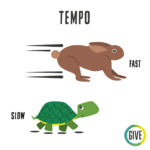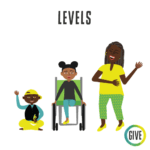Make a Wave Dance
Contribution de Ana Cantoran
![]()
![]()
Description
This activity strengthens social emotional skills in the classroom through co-generating ideas, celebrating individual creativity and imagination as your students dive into shared experiences through movement exploration in dance.
instructions
- Introduce yourself and tell students you are going to play a game called “Make a Wave.” “This game will help us know each other better and perhaps learn new and interesting things about our classmates and teachers while creating a dance. But first, what is a wave?” Ask students and Classroom Professionals to close their eyes or let their focus drift and think of the word wave. “What images or ideas come to mind when we think of a wave?” Invite students to share their thoughts popcorn-style or one-mic style if more structure is needed.
- Ask a Classroom Professional or student to write down a list of the ideas shared and, if they are comfortable with it, include drawings as well.
- “Now we’re going to make waves with our bodies. We’ll start quietly, and we can add a layer of sound later on. If you need help remembering all the kinds of waves you can always reference the list we created. New waves are also welcome. The drawings we made [if applicable] can inform the quality of our movements.”
- “Write the word wave in the air. Choose one part of your body—it can be your finger, head, eyes, nose, elbow, any part that is safe for you and allows you to keep your balance. Try different parts of the body, different tempos, levels, and movement qualities.”


- “Now that we feel more comfortable exploring waves in silence, we can add a layer of sound to our exploration. Our bodies can make sound by using our voice or making percussive sounds with our hands and feet. Be aware of volume this time.”
Transition vers l'activité
- You can start or accompany this transition by playing the sound of ocean waves in the background. Here is an external audio sample.
- Lead students through a simple stretching activity.
Transition hors de l'activité
From small groups to full-group circle, students can transition using a slow tempo and one movement quality from the list.
Aménagement de la salle de classe
Begin the class sitting in proscenium style. Transition to small groups and end in a full-group circle.
Supports/Matériaux adaptatifs/Outils
- Use a board or screen to write and show the list of waves and drawings of waves to support choice-making when exploring movement qualities.
- Display vocabulaire visuel to support choice-making.
- Prepare a list of wave ideas ahead of time for students to choose from. Model them for students.
Rôles possibles pour les professionnels de la classe
- Writing down the list of waves.
- Taking pictures for documentation.
- Floating and supporting students as needed.
- Leading small groups in the movement exploration.
Réglages pour l'instruction à distance
![]()
- Use the chat to crowdsource ideas, images, and types of waves.
- Students can unmute all together or one at a time to make wave or percussive sounds.
- Try this as a mirroring activity where one student models and the rest of the group copies the movement.
